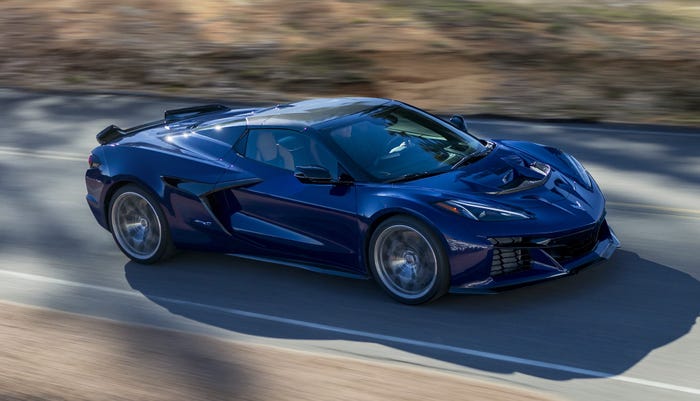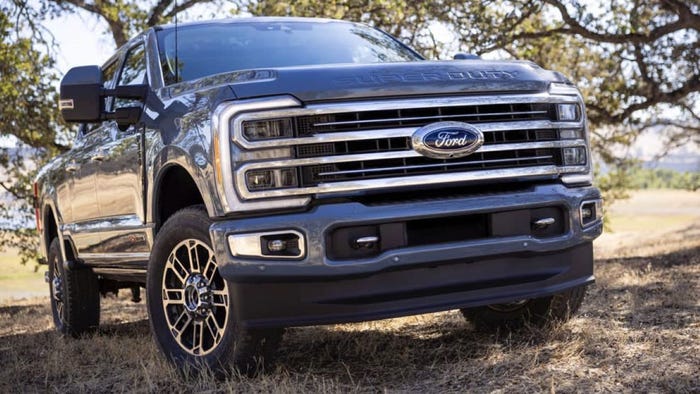Demand Increases For Used Cars
The used-car market is enjoying relatively good times, in part because of the tough times the nation and the new-car industry have been experiencing. Many cautious buyers — especially those hit by the recession's one-two punch of job instability and reduced housing values — are bypassing new cars and opting for less-expensive pre-owned vehicles.


Related document: Ward's 2010 Dealer Remarketing 150
The used-car market is enjoying relatively good times, in part because of the tough times the nation and the new-car industry have been experiencing. Many cautious buyers — especially those hit by the recession's one-two punch of job instability and reduced housing values — are bypassing new cars and opting for less-expensive pre-owned vehicles.
“Consumers are searching out deals and are still shying away from high-dollar vehicles in a weaker economy,” says Jonathan Banks, executive automotive analyst for the National Automobile Dealers Assn.'s NADA Used Car Guide.
The used-to-new sales ratio jumped from its normal 2.5:1 level of the past decade to 3.4:1 in 2009, says Tom Webb, chief economist for Manheim Consulting, a unit of the Manheim auto-auction company.
The ratio is expected to slip to 3.2:1 this year “but it appears the dynamics of the industry will keep the ratio above 3-to-1 for some time,” he says. “The simplest way for households to repair balance sheets is to postpone major purchases.
“And that's what they are doing with respect to new vehicles — waiting.”
The used-car market may feel healthier than its new-car counterpart, but it's still not 100%.
Last year, used-car sales dropped to 35.5 million. Webb predicts 37 million deliveries this year, but that's still below pre-recession levels of 40 million.
But dealership used-car operations this year are seeing higher profits, stronger prices and more frequent inventory turns, Webb tells Ward's.
That's a vast improvement from last year when dealerships' used-car operations, while outperforming new-car departments, on average had the worst year in a 30-year recorded history, says NADA Chief Economist Paul Taylor.
Nevertheless, used-car sales were a savior for many dealers whose new-car deliveries fell hellishly low in 2009.
“Used was a real headwind that helped us last year,” says Earl Hesterberg, CEO of Group 1 Automotive, a dealership chain with 95 stores.
Auto makers' certified pre-owned programs helped save the day, he says. “CPO is powerful on a lot of different levels.”

NADA Chairman Ed Tonkin, an Oregon dealer, says, “We love the used-car business, and CPO is like a separate franchise.”
Market forces combined to push used-car prices to record highs in May. As supplies depleted, wholesale prices climbed at the fastest pace on record.
“Prices pulled back in June as wholesale values were bumping up against the ceiling imposed by new-vehicle prices,” Webb says.
Wholesale prices increased 5.1% in 2009. Further increases in 2010 put June prices 5.3% ahead of year-ago levels.
To meet demand, franchised dealers are on the lookout for used products to remarket, particularly trade-ins and off-lease vehicles, although the latter's numbers are declining.
“Franchised dealers are grabbing low-mileage vehicles,” Banks tells Ward's. “They are keeping those from getting to auction. Independent dealers don't even have a chance at them.”
That and other factors have increased auction prices, although auction volumes are down as a consequence of dealers sending fewer vehicles in that direction.
Wholesale buyers aren't grumbling too much about higher auction prices because “it's a win-win when someone sells a car that doesn't fit his needs and someone else buys that car and goes on to make a healthy profit off of it,” Webb says.
Two years ago, some domestic auto makers scaled back on leasing or ended it altogether. The effects of that are starting to show up today, as fewer cars come off lease and head to remarketing channels.
Off-lease volumes are expected to drop to 2.5 million units this year, go below 1.5 million in 2013 and then slowly climb to about 1.75 million in 2015, Webb predicts.
Low-mileage vehicles continue to command the highest prices on the used-car market. But high-mileage vehicles carry “less negative impact” than previously, Banks says. Franchise dealers are stocking more of those.
“During the last decade, dealers have expanded the range of used vehicles they offer in their stores,” says Manheim CEO and President Dean Eisner. “Today's 80,000-mile (128,000-km) vehicle is thought of as being in its prime, with many years of driving ahead of it.”
Auto makers are producing more durable cars than before, making the purchase of high-mileage used vehicles less risky for consumers.
Because of that, as well as overall short supplies, franchised dealers are stocking a greater mix of pre-owned vehicles, many with higher odometer readings. In the past, franchised dealers typically sold relatively low-mileage used vehicles, while independent dealers stocked high-mileage inventory.
“But that gap has narrowed,” Webb says.
One reason for the higher-mileage vehicles at retail is that daily rental firms, major sources of used cars, are keeping their fleets in service longer, tallying more miles.
The average mileage has increased for all classes of vehicles sold at auction, according to Manheim.
With greater consumer interest and higher values, “even for older, high-mileage units, the importance of the remarketing industry has grown,” Eisner says in introducing Manheim's mid-year Used-Car Market Report.
The possibility of auto makers offering hefty incentives to move the new metal gives pause to some wholesale used-car buyers.
“That could make the new-to-used monthly payment ratio even closer, thus the hesitancy to step up strong on late model units at the auctions,” says Ricky Beggs, manager editor at Black Book, a used-car value guide.
The most recent new-car incentives haven't hurt used-car sales much because the latest marketing lures have focused on lower interest rates and lease programs, Banks says. “Slapping an $8,000 cash incentive on the hood of a new car would have a greater impact on used-car sales.”
For dealers replenishing inventories, the low availability of used vehicles requires greater efforts in finding the right ones, he says.
Webb attributes the low supply in part on deteriorating new-vehicle sales that went from 16.1 million units in 2007, to 13.2 million in 2008, and 10.4 million last year. That drop hurt used-car sales, too.
“Blame the softness in used-vehicle sales on the weak new-vehicle market,” he says. “After all, a retail new-vehicle sale usually begets at least one used-vehicle sale in short order.”
Some dealers lament about how hard it is to find cars and trucks to restock their lots. “In reality, it wasn't the difficulty in finding them, but rather the prices that had to be paid that created the challenge,” Webb says.
As used-car supplies shrank, franchised dealers saw prices rise and competition stiffen among themselves and independent dealers.
“And the shortage of used vehicles came at a time when franchised dealers were relying even more on their used-vehicle operations to support the overall dealership,” Webb says.
It is not unusual now for inventory-hungry dealers to attend local live auctions while at the same time using mobile devices and computer terminals at the facilities to bid on vehicles at online auctions.
An NADA study finds that dealerships with stand-out used-car operations share common traits.
One of them is correct pricing from the get-go. Inventory-management software helps dealers determine market demand and competitive pricing so inventories turn faster and with less need for markdowns.
“Dealers doing well with used cars spend a lot of time getting prices right,” Banks says.
The study also finds that successful used-car departments strive to treat customers well.
“BMW and Mercedes-Benz dealers do a real good job in customer satisfaction for used-car customers,” Banks says. “Someone who buys a used 7-Series BMW is treated like someone buying a new 7-Series.”
Some dealers have stumbled selling used cars. Among them are several who lost their franchises when General Motors Co. and Chrysler Group LLC slashed their dealer ranks last year.
“They turned to selling used cars and found the transition difficult,” Webb says. “Their survival rate was low because of high fixed costs associated with large and expensive facilities and their inability to find adequate floorplan credit.”
Auto makers cutting back on production of late unwittingly have helped dealership used-car operations, he says, noting that manufacturers don't force cars on dealers like before.
“New-vehicle inventory at dealerships has consistently fallen and is now at its lowest level in more than 35 years of recordkeeping,” Webb says. “Freed up from the need to push unwanted new-vehicle inventory, franchised dealers enjoyed higher used-vehicle profits in the first half of 2010.”
Lingering economic woes make for a tough automotive market, used or new. Consumer confidence, measured as an index, is half of what it was in 2005, but up from a low point registered in March of 2009.
Webb remains optimistic that better times are ahead, “but significant challenges still are out there. I'd love to see the labor market improve.”
Adds Eisner: “Although the credit crisis has eased, bringing more shoppers into dealerships, consumers are still struggling under the weight of high unemployment and a weak housing market.”
One sign of an improving economy is that vehicle repossessions had the biggest percentage decline after their record year of 2009.
Repos remain a major source of vehicles sold at auction. They carry something of a stigma on the premise that “if someone wasn't making payments on his car, he probably wasn't taking care of it either,” Webb says.
But “targeted reconditioning” often spurs higher bids on those units.
Citing high vehicle-scrappage rates, Banks foresees an impending demand for the auto industry in general.
“Today, more cars are being disposed of than built,” he says. “That's unusual. It's creating a pent-up demand.”
About the Author(s)
You May Also Like
_(2).jpg?width=700&auto=webp&quality=80&disable=upscale)


